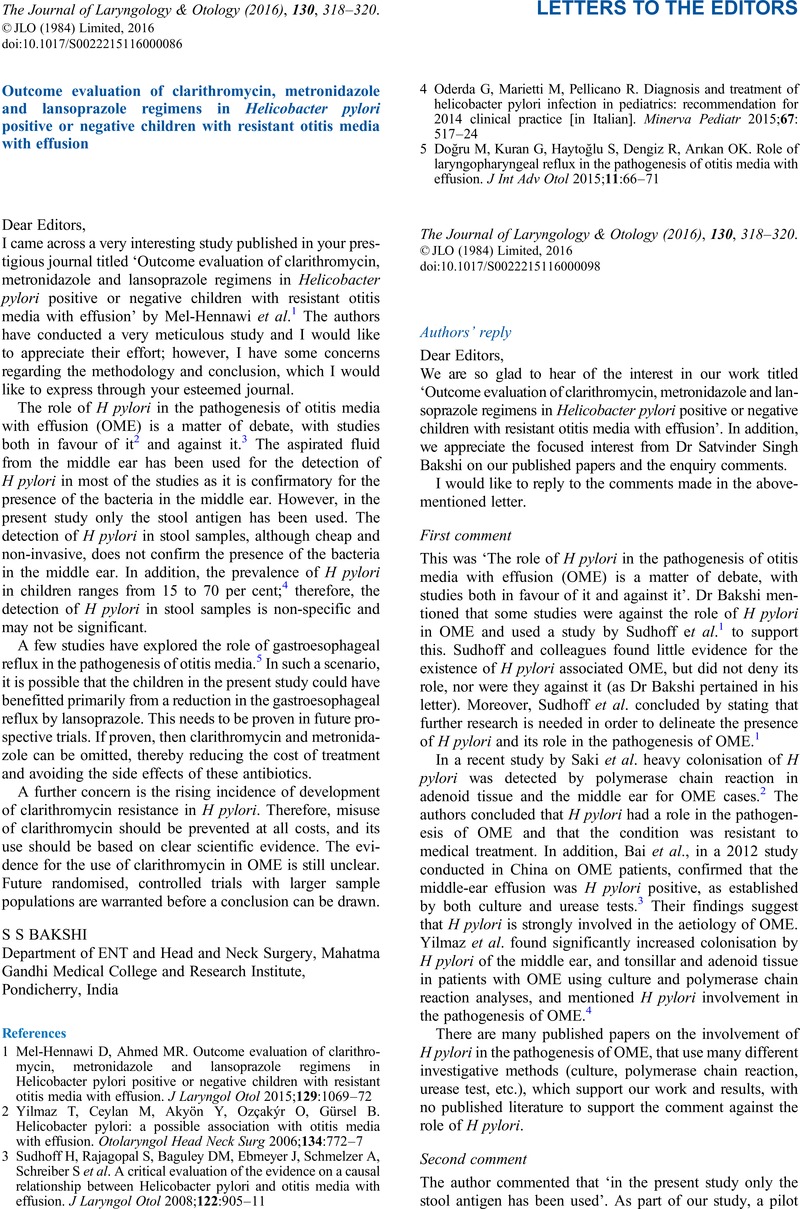No CrossRef data available.
Article contents
Authors' reply
Published online by Cambridge University Press: 15 February 2016
Abstract
An abstract is not available for this content so a preview has been provided. Please use the Get access link above for information on how to access this content.

- Type
- Letters to the Editors
- Information
- Copyright
- Copyright © JLO (1984) Limited 2016
References
1Sudhoff, H, Rajagopal, S, Baguley, DM, Ebmeyer, J, Schmelzer, A, Schreiber, S et al. A critical evaluation of the evidence on a causal relationship between Helicobacter pylori and otitis media with effusion. J Laryngol Otol 2008;122:905–11CrossRefGoogle ScholarPubMed
2Saki, N, Samarbaf Zadeh, AR, Sheikhpour Jonaky, R, Noori, SM, Kayedani, GA, Nikakhlagh, S.The prevalence rate of Helicobacter pylori infection in chronic otitis media with effusion patients. Jundishapur J Microbiol 2014;7:e15694CrossRefGoogle ScholarPubMed
3Bai, X, Wang, D, Fan, Z, Han, Y, Xu, L, Zhang, G et al. Helicobacter pylori may cause otitis media with effusion: a pilot study. B-ENT 2012;8:261–4Google ScholarPubMed
4Yilmaz, T, Ceylan, M, Akyön, Y, Ozçakýr, O, Gürsel, B.Helicobacter pylori: a possible association with otitis media with effusion. Otolaryngol Head Neck Surg 2006;134:772–7CrossRefGoogle ScholarPubMed
5Melake, NA, Shaker, GH, Salama, MA.Incidence of Helicobacter pylori infection and their clarithromycin-resistant strains in otitis media with effusion regarding phenotypic and genotypic studies. Saudi Pharm J 2012;20:345–53CrossRefGoogle ScholarPubMed
6Makristathis, A, Pasching, E, Schütze, K, Wimmer, M, Rotter, ML, Hirschl, AM.Detection of Helicobacter pylori in stool specimens by PCR and antigen enzyme immunoassay. J Clin Microbiol 1998;36:2772–4CrossRefGoogle ScholarPubMed
7Oderda, G, Rapa, A, Ronchi, B, Lerro, P, Pastore, M, Staiano, A et al. Detection of Helicobacter pylori in stool specimens by non-invasive antigen enzyme immunoassay in children: multicentre Italian study. BMJ 2000;320:347–8CrossRefGoogle ScholarPubMed
8Gulcan, EM, Varol, A, Kutlu, T, Cullu, F, Erkan, T, Adal, E et al. Helicobacter pylori stool antigen test. Indian J Pediatr 2005;72:675–8CrossRefGoogle ScholarPubMed
9Ables, AZ, Simon, I, Melton, ER.Update on Helicobacter pylori treatment. Am Fam Physician 2007;75:351–8Google ScholarPubMed
10Iranikhah, A, Ghadir, MR, Sarkeshikian, S, Saneian, H, Heiari, A, Mahvari, M.Stool antigen tests for the detection of Helicobacter pylori in children. Iran J Pediatr 2013;23:138–42Google ScholarPubMed
11Tasker, A, Dettmar, PW, Panetti, M, Koufman, JA, Birchall, JP, Pearson, JP.Is gastric reflux a cause of otitis media with effusion in children? Laryngoscope 2002;112:1930–4CrossRefGoogle ScholarPubMed
12O'Reilly, RC, Soundar, S, Tonb, D, Bolling, L, Yoo, E, Nadal, T et al. The role of gastric pepsin in the inflammatory cascade of pediatric otitis media. JAMA Otolaryngol Head Neck Surg 2015;141:350–7CrossRefGoogle ScholarPubMed
13Al-Saab, F, Manoukian, JJ, Al-Sabah, B, Almot, S, Nguyen, LH, Tewfik, TL et al. Linking laryngopharyngeal reflux to otitis media with effusion: pepsinogen study of adenoid tissue and middle ear fluid. J Otolaryngol Head Neck Surg 2008;37:565–71Google ScholarPubMed
14Gessner, BD, Bruce, MG, Parkinson, AJ, Gold, BD, Muth, PT, Dunaway, E et al. A randomized trial of triple therapy for pediatric Helicobacter pylori infection and risk factors for treatment failure in a population with a high prevalence of infection. Clin Infect Dis 2005;41:1261–8CrossRefGoogle Scholar
15Masoodi, M, Talebi-Taher, M, Tabatabaie, K, Khaleghi, S, Faghihi, AH, Agah, S et al. Clarithromycin vs. gemifloxacin in quadruple therapy regimens for empiric primary treatment of Helicobacter pylori infection: a randomized clinical trial. Middle East J Dig Dis 2015;7:88–93Google ScholarPubMed
16Mokhtare, M, Agah, S, Fakheri, H, Hosseini, V, Rezaei Hemami, M, Ghafoori, SM.Efficacy of clarithromycin containing bismuth-based regimen as a second-line therapy in Helicobacter pylori eradication. Middle East J Dig Dis 2015;7:75–81Google ScholarPubMed
17Harb, AH, Chalhoub, JM, Abou Mrad, R, Sharara, AI.Systematic review and meta-analysis: full- vs. half-dose anti-microbials in clarithromycin-based regimens for Helicobacter pylori eradication. Aliment Pharmacol Ther 2015;42:131–41CrossRefGoogle ScholarPubMed
18Yoon, KH, Park, SW, Lee, SW, Kim, BJ, Kim, JG.Clarithromycin-based standard triple therapy can still be effective for Helicobacter pylori eradication in some parts of the Korea. J Korean Med Sci 2014;29:1240–6CrossRefGoogle ScholarPubMed
19Iino, Y, Yoshida, N, Kato, T, Kakizaki, K, Miyazawa, T, Kakuta, H.Clinical effects of clarithromycin on persistent inflammation following Haemophilus influenzae-positive acute otitis media. Acta Otolaryngol 2015;135:217–25CrossRefGoogle ScholarPubMed
20Chen, K, Wu, X, Jiang, G, Du, J, Jiang, H.Low dose macrolide administration for long term is effective for otitis media with effusion in children. Auris Nasus Larynx 2013;40:46–50CrossRefGoogle ScholarPubMed
21Iino, Y.Efficacy of macrolide therapy for children with serous otitis media [in Japanese]. Jpn J Antibiot 2001;54(suppl C):23–5Google ScholarPubMed




